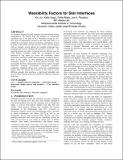Wearability Factors for Skin Interfaces
Author(s)
Liu, Xin; Canepa Vega, Katia; Maes, Patricia; Paradiso, Joseph A
DownloadAccepted version (1.852Mb)
Terms of use
Metadata
Show full item recordAbstract
As interfaces progress beyond wearables and into intrinsic human augmentation, the human body has become an increasingly important topic in the field of HCI. Wearables already act as a new layer of functionality located on the body that leads us to rethink the convergence between technology and fashion, not just in terms of the ability to wear, but also in how devices interact with us. Already, several options for wearable technology have emerged in the form of clothing and accessories. However, by applying sensors and other computing devices directly onto the body surface, wearables could also be designed as skin interfaces. In this paper, we review the wearability factors impacting wearables as clothes and accessories in order to discuss them in the context of skin interfaces. We classify these wearability factors in terms of body aspects (location, body movements and body characteristics) and device aspects (weight, attachment methods, accessibility, interaction, aesthetics, conductors, insulation, device care, connection, communication, battery life). We discuss these factors in the context of two different example skin interfaces: A rigid board embedded into special effects makeup and skin-mounted soft materials connected to devices.
Date issued
2016-02Department
Massachusetts Institute of Technology. Media Laboratory; Program in Media Arts and Sciences (Massachusetts Institute of Technology)Journal
Proceedings of the 7th Augmented Human International Conference 2016
Publisher
ACM Press
Citation
Liu, Xin et al. "Wearability Factors for Skin Interfaces." Proceedings of the 7th Augmented Human International Conference 2016, Geneva, Switzerland, ACM Press, February 2016. © 2016 Association for Computing Machinery
Version: Author's final manuscript
ISBN
9781450336802